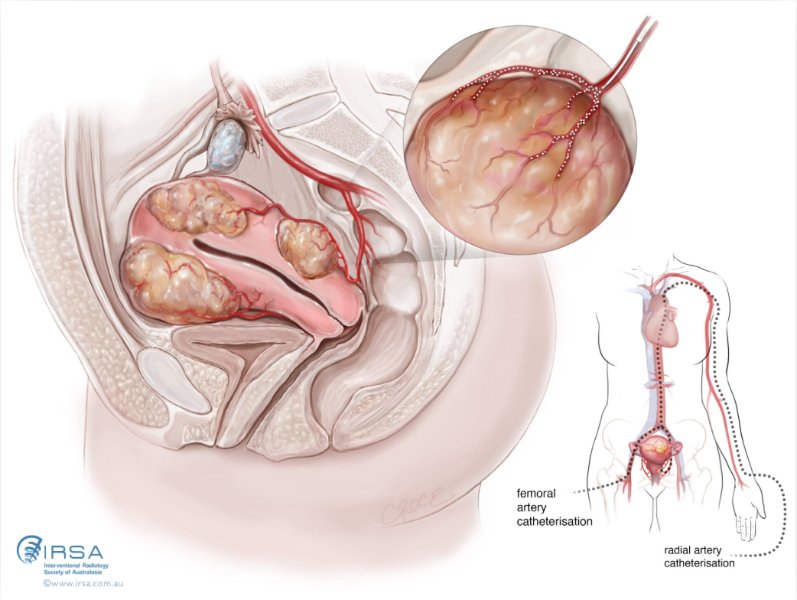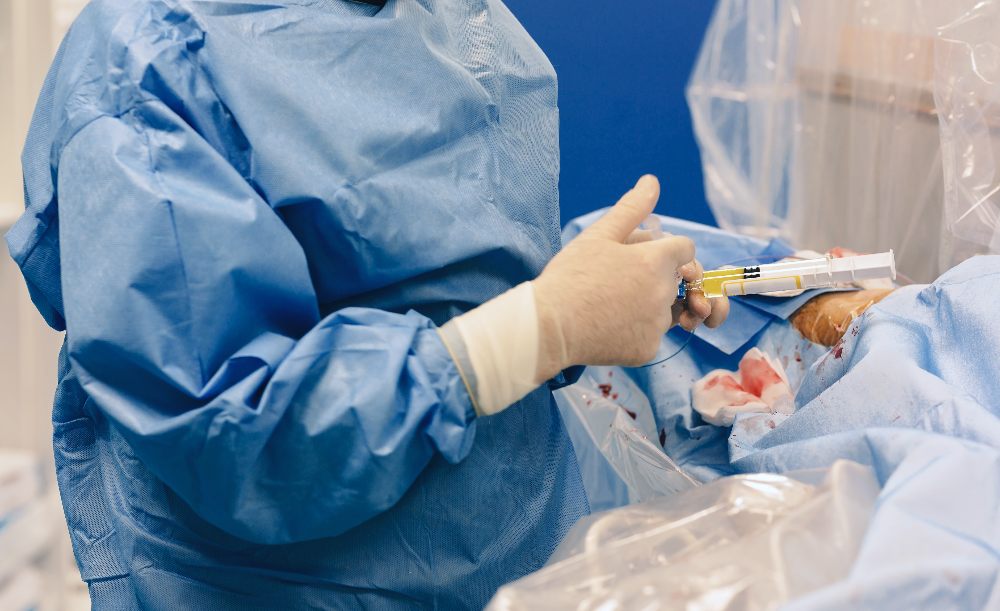UTERINE ARTERY EMBOLISATION MELBOURNE
FIBROIDS AND ADENOMYOSIS TREATMENT
Learn about Uterine Artery Embolisation including the procedure, benefits, risks and recovery:
UTERINE ARTERY EMBOLISATION MELBOURNE
Source: Dr Philip Chan – MBBS, MMed (Radiology), FRANZCR, EBIR.
Interventional Radiologist.
WHAT IS A UTERINE ARTERY EMBOLISATION
What is Uterine Artery Embolisation (UAE) – A Uterine Artery Embolisation (UAE) is a minimally invasive procedure used to treat fibroids or adenomyosis.
Fibroids – Fibroids are noncancerous growths in or on the uterus, made of muscle and connective tissue.
Adenomyosis – Adenomyosis is a condition where endometrial tissue (tissue that lines the uterus) grows into the uterine muscle.
Both Fibroids and Adenomyosis can cause pelvic pain, pressure, heavy periods, bloating, anaemia, frequent urination and an enlarged uterus.
A Uterine Artery Embolization (UAE) blocks the blood flow to the uterine arteries causing the fibroid and adenomyosis tissue to shrink over time to help relieve the painful symptoms.

Source: Cleveland Clinic – Uterine Artery Embolisation
HOW IS A UTERINE ARTERY EMBOLISATION PERFORMED
A Uterine Artery Embolisation is a minimally invasive operation is performed through a 2-3 mm hole through an artery in the wrist or groin.
A microcatheter, a small hollow plastic tube, is carefully navigated into the uterine arteries under image guidance.
Once in position, microscopic particles are injected until the artery is completely blocked.
The operation typically takes 45 minutes to an hour, and can be safely performed under sedation and local anaesthesia.
A regional block may also be performed to provide better post operative pain relief.

Source: John Hopkins – Uterine Artery Embolisation
WHO IS A SUITABLE CANDIDATE FOR A UTERINE ARTERY EMBOLISATION
A Uterine Artery Embolisation may be suitable for you if you have fibroids or adenomyosis and:
Heavy menstrual flow
Pressure symptoms due to a bulky uterus or fibroids
Anaemia caused by excessive blood loss
Wish to keep your uterus
Wish to avoid a major operation
A Uterine Artery Embolisation only requires local anesthesia and sedation, has minimal risks, and has a quick recovery time compared to traditional open surgery.
ADVANTAGES OF UTERINE ARTERY EMBOLISATION
A Uterine Artery Embolisation procedure has the following advantages:
Uterine preservation
Minimally invasive procedure – Shorter hospitalisation (next day discharge) and shorter recovery period (14 days)
Lower risk profile – Less bleeding risk and lower infection risk
Effective for multiple fibroids
No unsightly wounds
Suitable for women on blood thinners.
PREPARING FOR A UTERINE ARTERY EMBOLISATION
Preparing for a Uterine Artery Embolisation – Your doctor and the WIRES Radiology team will discuss with you the procedure process and hospital administration needs.
Investigations and tests – You may require more relevant investigations such as blood tests, ultrasound, CT or MRI as part of your preparation for the procedure.
Fasting and overnight hospital stay – Generally, you are required to fast for 6 hours before the procedure. Please prepare for an overnight hospital stay (even if you are expecting to be discharged the same day).
Driving – Have someone to drive you home after the procedure.
Medications – Your doctor will review your list of medications and advise which medications you may need to stop before the procedure and when you may resume taking them again.
RECOVERY – AFTER A UTERINE ARTERY EMBOLISATION
Overnight hospital stay – Please prepare for an overnight hospital stay for observation and pain management. You will likely experience pelvic pain/cramps in the first 12-24 hours. These will slowly settle over the next 7-14 days.
Pain management – You may have aching at the incision site and in your abdominal and pelvic muscles. Take pain relief medication for soreness as recommended by your doctor.
Activity – You will be advised avoid strenuous activity or lifting anything over 5 kilos. After the two week mark most patients can increase their activity levels.
Post embolisation syndrome – Post embolisation syndrome is caused by the body’s reaction to the operation. Patients often feel fatigued, have low grade fever, nausea, vomiting, low appetite, generalised muscle and joint aches – similar to having a cold without the head symptoms.
These symptoms are easily managed with paracetamol and ibuprofen, and should resolve after 7-14 days.
Your doctor will discuss with you and answer any questions you may have in relation to your individual rehabilitation, activity, medication and recovery.
FREQUENTLY ASKED QUESTIONS
A Uterine Artery Embolisation is generally a short 45 minutes to 1 hour procedure. Most patients will stay overnight in hospital for observation.
Light activities – Light activities can typically be resumed within two weeks following the procedure.
High-impact activities – We recommend avoiding high-impact activities for at least four weeks after the procedure.
Please discuss your rehabilitation with your doctor.
First month – After your initial recovery period of 1 month, most patients will have recovered from the procedural symptoms.
Your periods may become erratic or stop after a UAE, especially if you are over the age of 40 or perimenopausal.
Ongoing relief – 3-6 months after a Uterine Artery Embolisation most women experience lighter menstrual bleeding as well as less pelvic pain and pressure as the fibroids or adenomyosis tissue shrinks.
Risks – Like any medical procedure, a Uterine Artery Embolisation carries certain risks. Potential risks may include but not limited to:
- Infection from the insertion site
- Bruising or injury in the insertion site or within the uterus
- Infertility problems with future pregnancy
- Inconsistent menstrual cycle
Your doctor will outline all the risks specific to your situation.
A Uterine Artery Embolisation is usually well-tolerated procedure. It is a minimally invasive interventional radiology procedure performed under local anaesthetic.
Immediately after the procedure – After the procedure, some patients experience mild to moderate soreness, swelling or aching at the insertion site.
Most patients feel only mild discomfort or pressure as the catheter is inserted and guided the blood vessels. A local anesthetic is used at the insertion site, which helps minimise pain.
Post surgery – Cramping from the procedure for the first 6-12 hours is common. Most post-procedure pain is generally manageable with over-the-counter medications.
Your doctor will discuss and monitor a pain management plan you.
Uterine Artery Embolisation is a safe and effective procedure, but like any medical treatment, it has potential side effects.
Common Side Effects may include:
Pain and Cramping – Moderate to severe pelvic pain is common for a few days after the procedure but improves with medication.
Post-Embolisation Syndrome – Flu-like symptoms (fatigue, nausea, low fever, mild discomfort) may last a few days to a week.
Vaginal Discharge and Spotting – Light bleeding or brown discharge can continue for a few weeks to months as fibroids shrink.
Temporary Changes in Menstrual Cycle – Periods may be heavier, lighter, irregular, or even stop temporarily before returning to normal.
Your doctor will fully explain the procedure and any potential side effects and mitigation strategies to make you as comfortable as possible during and after the procedure.


